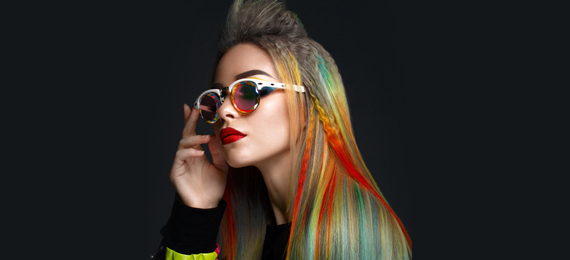
The ancient/modern beauty standards made people believe that black hair makes them look beautiful and young. To fit into the standards of society, hair dye has been invented. But when was hair dye invented? Who invented hair dye? And where hair dye comes from? This article will help you understand the history of hair color.
What Is Hair Dyeing or Hair Coloring?
Hair dyeing/coloring is a process of changing the natural hair color. It might be to cover grey hair or to be fashionable and trendy.
During the initial stages, jet black hair dye was very famous in Ancient Rome and it took several years for the discovery of various other hair colors. For the ancient people, hair color was not only used for the purpose of beauty, but it was also an indication of pride for the civilizations such as the Saxon and the Gaul. This was used to show their power and rank on the battlefield.
1. The First Hair Color Invented by Greeks and Romans Was Brown.
- A. True
- B. False
Who Invented Hair Dye?
The practice of dyeing hair has been followed since ancient times. It involves treating one’s hair with various chemical components. When was hair dye created? The Greeks and Romans also discovered a toxic hair dye that was made from leeches that had been fermented in a lead vessel for around 2 months. During ancient times, people used plants such as henna, senna, turmeric, and amla to obtain dye. The book Eighteen Books of the secret of Art and Nature was released in 1661 and it contained various methods of coloring one’s hair with different colors such as black, red, brown, etc.
History of Hair Dye
During ancient times, prostitutes were required to have yellow/blonde hair in order to indicate their profession. Many people used wigs and many used plants or nuts ashes to dye in order to change their hair color.
In the dark ages, red hair was popular due to genetic mutation but many people believed that red hair was an indication of witchcraft. But later, during the reign of Queen Elizabeth 1, red hair became more acceptable.
English professor William Henry Perkin in the attempt of finding a cure for malaria discovered the first synthesized dye in 1863. The color was mauve and hence was named mauveine. Later, Chemistry professor August Wilhelm von Hoffman discovered PPD derived from mauveine. Initially, in the 1860s the reactivity of the para-phenylenediamine (PPD) with air was found to create synthetic hair dyes. It is still used as a base for several permanent hair dyes.
The French chemist Eugène Schueller, the founder of L’Oréal is recognized for creating the first synthetic hair dye in 1907. Initially, it was called Aureole and then the name was dubbed to L’Oréal. Schwarzkopf is the first one to launch home color products.
Later, in the 1930s, the platinum blonde was one of the famous types of hair coloring. It was featured by the young star Jean Harlow. Howard Hughes released a film called ‘Platinum Blonde’ and very soon people started to follow the hair trend.
In the 1950s, Lawrence Gelb with his wife Jane Claire introduced a one-step hair dye product that changed the color of hair without using bleach. It can be done at home and hence was a huge hit among the ladies who secretly wanted to color their hair.
In the late 1960s, many people started to adopt the trend of hair coloring and 1968 was the last year that asked for passports to mention the hair color of the candidate. Many people who were against the hair coloring trend started to see the concept as a new normal. The idea of hair coloring was open and normalized among people.
Some of the main ingredients of present-day hair colors include ammonia, hydrogen peroxide, alcohol, PPD, etc. There are several other nutrient-rich hair colors that contain keratin, argan oil, etc.
Currently, an estimation of around 70% of women uses hair coloring products in the United States. From simple highlights to balayage and sombré various other safe hair color methods have been introduced, but still the love and craze towards hair coloring is not reduced. The makeup practices that we follow today are actually safe when compared to history. Find some of these scary beauty practices in history that can make you go crazy